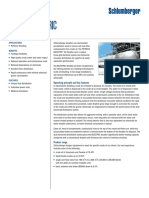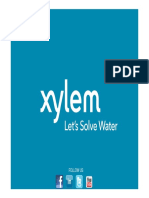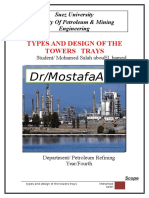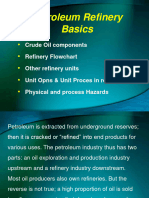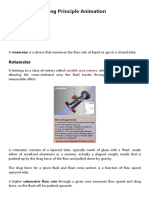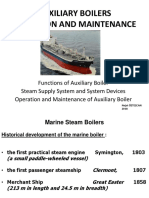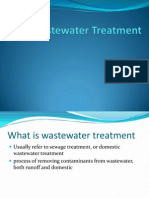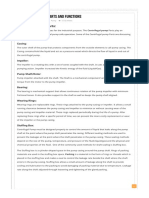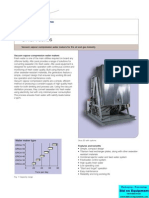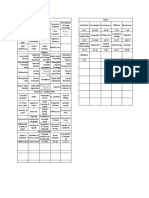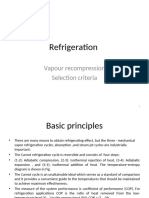Utilities Requirements in Process Industries
Utilities Requirements in Process Industries
Uploaded by
fantagero2001Copyright:
Available Formats
Utilities Requirements in Process Industries
Utilities Requirements in Process Industries
Uploaded by
fantagero2001Copyright
Available Formats
Share this document
Did you find this document useful?
Is this content inappropriate?
Copyright:
Available Formats
Utilities Requirements in Process Industries
Utilities Requirements in Process Industries
Uploaded by
fantagero2001Copyright:
Available Formats
Utilities Requirements in Process Industries
Introduction Every industrial plant, whether it produces chemicals of food, cars or computers, depends for its operation on one or more utility systems. All plants require energy and most also need water, compressed air and other gasses, waste treatment and ventilation all supplied through utility networks and their associated equipment. In purely economic terms, it can be a mistake to neglect utilities. In some industries like electronics and pharmaceuticals utilities may be make up only a small fraction of the total operating costs, but in others- including brewing and papermaking the utilities bill can make or break a project. Energy wastage is equivalent to environment pollution, and this is not the only route by which the utility systems are likely to contribute to a sites overall burden of environment damage. Air compressors produce waste oil, ineffective wastewater treatment plants discharge harmful chemicals to water ways, and refrigeration systems could leak ozone-destroying chemicals and greenhouse gases. Most utilities need to be very reliable, when things go wrong they have the potential to bring an entire site to a halt. In fact, utilities may need to be even more reliable than the processes they serve, because process and site safety often depends on the continued supply of utilities including compressed air, and cooling water. 4 basic groups of utility systems based on their number and nature that vary from site to site:
1. Energy transfer: fuel, electricity, steam, hot water and other thermal fluids, cooling water and refrigeration. 2. Process water, potable water, wastewater. 3. Compressed air, inert gas, hydraulic fluids. 4. Ventilation and air conditioning. Cooling Water System Water cooling is a method of heat removal from components, where water is used as the heat transmitter. Water cooling is commonly used for cooling purposes in heat exchangers; cooling products from tanks or columns. The main mechanism for water cooling is convective heat transfer.
The advantages of using water cooling over air cooling include water's higher specific heat capacity, density, and thermal conductivity. This allows water to transmit heat over greater distances with much less volumetric flow and reduced temperature difference.
Industrial Usage Source: river water or well water The large mechanical induced-draft or forced-draft cooling towers in industrial plants such as power stations, petroleum oil refineries, petrochemical plants and natural gas processing plants continuously circulate cooling water through heat exchangers and other equipment where the water absorbs heat.
The Cooling Mechanism Plants continuously circulate cooling water through heat exchangers and other equipment where the water absorbs heat. The heat is then rejected to the atmosphere by the partial evaporation of the water in cooling towers where upflowing air is contacted with the circulating downflow of water. The loss of evaporated water into the air exhausted to the atmosphere is replaced by "make-up" fresh river water or fresh cooling water. Since the evaporation of pure water is replaced by make-up water containing carbonates and other dissolved salts, a portion of the circulating water is also continuously discarded as "blowdown" water to prevent the excessive build-up of salts in the circulating water.
Type of Water Used 1. High grade industrial water (produced by reverse osmosis) and potable water is sometimes used in industrial plants requiring high-purity cooling water. 2. Some nuclear reactors use heavy water as cooling. 3. For the main cooling system, normal water is preferably employed through the use of a heat exchanger as heavy water is much more expensive. Reactors may also use normal water for cooling. Environmental Impacts Direct cooled" systems are often used where the warmed water is returned directly to the aquatic environment, often at temperatures significantly above the ambient receiving water Thermal pollution. Discussions
Compressed Air Compressed air is supplied on industrial sites for 2 main uses:
1. Plant air for general use 2. Instrument air for control systems. Both of these duties require pressurized air at 6-7 bar. Plant air does not always need to be dried, but it is always filtered to prevent dust contaminating tools using it. Instrument air is dried to prevent condensation and water gathering in the distribution system and the control mechanisms.
Plant Air Systems Plant air systems typically consist of a series of air compressors that supply air for tools, machines and instruments. Plant air is normally used for purging equipment containing inert gas to allow entry for maintenance. Also used for driving tools during maintenance and some minor process units such as drum filling pumps and agitators. These tools and users are at ambient temperatures and have a short residence time for the air, therefore there is a little opportunity for condensing water to collect. Main units are like filters, compressors, coolers and valving. Many installations need only small amounts of constant plant air flow. Where the plant air flow is not critical to the operation, only one plant air compressor needs to be installed to give adequate reliability.
Requirements of Instrument Air Systems Instrument air, are used for plant pneumatic instruments such as steam flow meters, pressure controllers and valve positioners. The instrument air is required to regulate automatically the opening of control valves of steam driven turbines. The instrument air should be dried to a dew point and will not cause condensation at the lowest site ambient temperature. The air system should be capable of supplying instrument air and possibly plant air to consumers at the peak simultaneous demand rate. The instrument air should be free from solids, oil, noxious gases and any corrosive materials. The particle sizes should less than 3m.
You might also like
- Product LoadDocument6 pagesProduct LoadDave Harrison Flores100% (1)
- Furnace Design and OperationDocument36 pagesFurnace Design and OperationkINGNo ratings yet
- Somoil - Soyo Processing Facilities Debottlenecking - FinalDocument33 pagesSomoil - Soyo Processing Facilities Debottlenecking - FinalHedi Ben MohamedNo ratings yet
- Xarios 350 ОписаниеDocument2 pagesXarios 350 ОписаниеzalupakozlaNo ratings yet
- Line and Equipment Opening / Oil Draining ProcedureDocument4 pagesLine and Equipment Opening / Oil Draining ProcedureRASHEED YUSUFNo ratings yet
- Benchmarking Study of The Refrigerated Warehousing Sector in CaliforniaDocument26 pagesBenchmarking Study of The Refrigerated Warehousing Sector in CaliforniaStacy WilsonNo ratings yet
- Oil Refinery Industry: Assignment 1Document19 pagesOil Refinery Industry: Assignment 1Azni ZulkifliNo ratings yet
- Flow Diagram SymbolsDocument5 pagesFlow Diagram SymbolshussainNo ratings yet
- Neutralization IWMDocument22 pagesNeutralization IWMusmansherdin100% (3)
- Module 4 (Design of Separation Columns)Document25 pagesModule 4 (Design of Separation Columns)esiri aluyaNo ratings yet
- Bielectric DesaalterDocument2 pagesBielectric DesaalterDaniele CirinaNo ratings yet
- Refrigeration (VCRS &VARS)Document19 pagesRefrigeration (VCRS &VARS)Vinesh TalpankarNo ratings yet
- Block Flow Diagrams: - Plant Design Is Made Up ofDocument85 pagesBlock Flow Diagrams: - Plant Design Is Made Up ofFahad Mahmood100% (1)
- Flow Measurement: Industrial InstrumentationDocument141 pagesFlow Measurement: Industrial InstrumentationKrishna VardhanNo ratings yet
- Assignment 1 - 1.5 Assignment 1 - Materials Properties and The Environment - AEASM1x Courseware - EdxDocument4 pagesAssignment 1 - 1.5 Assignment 1 - Materials Properties and The Environment - AEASM1x Courseware - EdxssvivekanandhNo ratings yet
- Elevated FlareDocument16 pagesElevated FlareDeepak SreekumarNo ratings yet
- 2) Introduction To Control ValveDocument30 pages2) Introduction To Control ValveChampKab0% (1)
- Water Treatment Plants Guide (Preventive Maintenance)Document8 pagesWater Treatment Plants Guide (Preventive Maintenance)wahyu hidayatNo ratings yet
- Compressors How To Achieve High Reliability & Availability (Electronics)Document55 pagesCompressors How To Achieve High Reliability & Availability (Electronics)Anonymous IGtWHoi0No ratings yet
- Working of Orifice Meter: Orifice Meter Structure and Working:-Orifice Meter Is An Instrument Which IsDocument2 pagesWorking of Orifice Meter: Orifice Meter Structure and Working:-Orifice Meter Is An Instrument Which Is9944805552100% (1)
- Alfa VapDocument2 pagesAlfa Vapkresimir.mikoc9765No ratings yet
- Akar Clarifier CatalogueDocument6 pagesAkar Clarifier CatalogueAnonymous O0lyGOShYGNo ratings yet
- Components and Treatments of Oilfield Produced WaterDocument7 pagesComponents and Treatments of Oilfield Produced WatermoheauNo ratings yet
- Cascade Control PDFDocument4 pagesCascade Control PDFDEBASISH SARKARNo ratings yet
- Water Desalination by Reverse OsmosisDocument44 pagesWater Desalination by Reverse Osmosispreyeshmohan100% (1)
- Tower Tray Oil and Gas IndustryDocument11 pagesTower Tray Oil and Gas IndustryHeet PatelNo ratings yet
- The Impact of Component Material Selection On Pump ReliabilityDocument7 pagesThe Impact of Component Material Selection On Pump ReliabilityAhmed Ibrahim Ahmed EissaNo ratings yet
- Presentation of Internship ProjectDocument34 pagesPresentation of Internship ProjectReinaldo Ongky Billy AnandoNo ratings yet
- Process Control and InstrumentationDocument46 pagesProcess Control and InstrumentationLeonardo ImmoNo ratings yet
- Furnace Control SystemDocument9 pagesFurnace Control SystemMUHAMMAD ASJAD AAMIR AAMIR AMINNo ratings yet
- GtryeDocument66 pagesGtryePholNo ratings yet
- Basic Refinery ProcessDocument44 pagesBasic Refinery ProcessJohn Kris San LuisNo ratings yet
- AnsimagDocument8 pagesAnsimagmani_208eeNo ratings yet
- Ebullated Reactor 3 Phase Fludized Bed Reactor 4 Upgrading Heavy OilsDocument10 pagesEbullated Reactor 3 Phase Fludized Bed Reactor 4 Upgrading Heavy OilsIvana Himawan SusantoNo ratings yet
- 23 22 13 Steam and Condensate PipingDocument15 pages23 22 13 Steam and Condensate PipingchabibNo ratings yet
- Rotameter Working Principle AnimationDocument3 pagesRotameter Working Principle Animationzhangyili100% (1)
- Aux BoilersDocument248 pagesAux Boilersamit singh100% (1)
- What Is The Difference Between LTCS and Carbon SteelDocument2 pagesWhat Is The Difference Between LTCS and Carbon Steelarianna_001No ratings yet
- All Heat Exchangers Are Not EqualDocument5 pagesAll Heat Exchangers Are Not EqualGesar GesarNo ratings yet
- By: Chitrakshi Goel M. Tech. ESTDocument60 pagesBy: Chitrakshi Goel M. Tech. ESTChitrakshi Goel100% (1)
- Knock Out Drum: Wiring DiagramsDocument8 pagesKnock Out Drum: Wiring DiagramsAlinaIordacheNo ratings yet
- Hvac - Centralized AC SystemDocument21 pagesHvac - Centralized AC SystemVala Vraj M.No ratings yet
- Plant LocationDocument32 pagesPlant LocationsunaNo ratings yet
- 1.0 Specification of Equipment / Material and Installation Standards 1.1 Specifications For Water Cooled Centrifugal Chiller Performance ParametersDocument8 pages1.0 Specification of Equipment / Material and Installation Standards 1.1 Specifications For Water Cooled Centrifugal Chiller Performance Parametersعامر شیخNo ratings yet
- Basic Presentation On CombipacDocument15 pagesBasic Presentation On CombipacTashmeet Singh100% (1)
- Water Treatment Controlling SystemDocument12 pagesWater Treatment Controlling SystemMuhammad Faisal JazuliNo ratings yet
- P&Id and OthersDocument18 pagesP&Id and OthersJesus A. ReynosoNo ratings yet
- Oil Refinery ProcessDocument44 pagesOil Refinery ProcessJunaid Iqbal100% (1)
- Membrane Pre TreatmentDocument10 pagesMembrane Pre Treatmentadalcayde2514No ratings yet
- AMPC Training Final Report PDFDocument36 pagesAMPC Training Final Report PDFIbrahim Al-HammadiNo ratings yet
- Waste Water TreatmentDocument57 pagesWaste Water TreatmentVishal PatelNo ratings yet
- Centrifugal Pump Parts and FunctionsDocument2 pagesCentrifugal Pump Parts and FunctionsOtuagaNo ratings yet
- Industrial Electric HeatersDocument12 pagesIndustrial Electric Heatersmayukhguha88No ratings yet
- Water Treatment and Supply Presentation Group 1 WeekendDocument37 pagesWater Treatment and Supply Presentation Group 1 WeekendetrimageoffreyNo ratings yet
- Energy Analysis of A Thermal Desalination Plant in Saudi ArabiaDocument28 pagesEnergy Analysis of A Thermal Desalination Plant in Saudi ArabiaJoel DaleNo ratings yet
- Heat ExchangerDocument20 pagesHeat ExchangerankitNo ratings yet
- Draft Boiler and FurnaceDocument8 pagesDraft Boiler and FurnaceJayandi FitraNo ratings yet
- Advances in Seawater Desalination TechnologiesDocument23 pagesAdvances in Seawater Desalination TechnologiesFrank FanNo ratings yet
- Alfa Laval Orca SeriesDocument2 pagesAlfa Laval Orca SeriesdumpuuNo ratings yet
- Pump EfficiencyDocument2 pagesPump EfficiencyRsn786No ratings yet
- Flow Measurement: - Introduced By: Taha Safi Ahmad Habbas Essa Qaisi Abdel Rahman AlnatourDocument29 pagesFlow Measurement: - Introduced By: Taha Safi Ahmad Habbas Essa Qaisi Abdel Rahman AlnatourAbd Al-NatourNo ratings yet
- PumpsDocument77 pagesPumpsPatrick Marcaida100% (1)
- Nomograph: Centrifugation BiochemistryDocument1 pageNomograph: Centrifugation BiochemistryStefani Ann CabalzaNo ratings yet
- Lecture 2 Vapour Compression Refrigeration System 1Document18 pagesLecture 2 Vapour Compression Refrigeration System 1Meftah ElfituriNo ratings yet
- Compressed Air SystemDocument15 pagesCompressed Air System185412No ratings yet
- Name: Onyekaba Nzubechukwu Jude MATRIC: 140404061 Difference Between Electrolux and Vapour Compression RefrigerationDocument2 pagesName: Onyekaba Nzubechukwu Jude MATRIC: 140404061 Difference Between Electrolux and Vapour Compression RefrigerationJudex OnyekabaNo ratings yet
- By Willem de Ruyter - Single Buoy Moorings Inc, Project Manager Sean Pellegrino - Chevrontexaco, Project Manager Hervé Cariou - Single Buoy Moorings Inc, Engineering Project ManagerDocument18 pagesBy Willem de Ruyter - Single Buoy Moorings Inc, Project Manager Sean Pellegrino - Chevrontexaco, Project Manager Hervé Cariou - Single Buoy Moorings Inc, Engineering Project ManagerHuma JavedNo ratings yet
- Feasibility Report On Production of LPG From Natural GasDocument18 pagesFeasibility Report On Production of LPG From Natural GasDanish KhanNo ratings yet
- Tobias, Jade C. Bsme 3A: Assignment # 5Document10 pagesTobias, Jade C. Bsme 3A: Assignment # 5Jade Tobias100% (1)
- A Quick Scan of Cold Chain Logistics Sector in China's Greater Bay AreaDocument42 pagesA Quick Scan of Cold Chain Logistics Sector in China's Greater Bay AreaIzhar Rahman DwiputraNo ratings yet
- PAC 105 Thesis-1Document175 pagesPAC 105 Thesis-1sajjadtiwana3949100% (1)
- Ibong Tiririt (Pipe 7)Document22 pagesIbong Tiririt (Pipe 7)PANZY GAMINGNo ratings yet
- Brochures I NXDocument12 pagesBrochures I NXZeeshanNo ratings yet
- Numerical Investigation of Air Cooled Condensers Using Different RefrigerantsDocument4 pagesNumerical Investigation of Air Cooled Condensers Using Different RefrigerantsEditor IJTSRDNo ratings yet
- HW 1 2Q1314 QuestionaireDocument1 pageHW 1 2Q1314 QuestionairejenninajubanNo ratings yet
- Dippin Dots CaseDocument6 pagesDippin Dots CaseRobert ParkerNo ratings yet
- Basics of Low Temp RefrigerationDocument29 pagesBasics of Low Temp RefrigerationstreamtNo ratings yet
- The Design and Performance Analysis of Refrigeration System Using R12 and R134A RefrigerantDocument19 pagesThe Design and Performance Analysis of Refrigeration System Using R12 and R134A Refrigerantjerico castilloNo ratings yet
- ME LabDocument40 pagesME Labflorenz rubricoNo ratings yet
- Chapter - I: Vitis Vinifera. L. Family-Vitiaceae and Origin - Armenia Near The Caspian SeaDocument19 pagesChapter - I: Vitis Vinifera. L. Family-Vitiaceae and Origin - Armenia Near The Caspian SeamonaliNo ratings yet
- Effect of Condenser Subcooling of The Performance of Vapor Compre PDFDocument11 pagesEffect of Condenser Subcooling of The Performance of Vapor Compre PDFusmanNo ratings yet
- Wa0006.Document10 pagesWa0006.Pratyush ChhabraNo ratings yet
- 1 s2.0 S0260877421004003 Main DESKTOP LJ83778Document15 pages1 s2.0 S0260877421004003 Main DESKTOP LJ83778عزام صالحNo ratings yet
- 444 1973Document98 pages444 1973avikrisadNo ratings yet
- Refrigeration and Air-ConditioningDocument24 pagesRefrigeration and Air-ConditioningKumar SahebNo ratings yet
- Refrigeration 1Document23 pagesRefrigeration 1Oilman006No ratings yet
- Calec-St Brochure Amended PDFDocument12 pagesCalec-St Brochure Amended PDFsultanprinceNo ratings yet
- Instrument Air - Compressed Air and Gas Drying-2Document21 pagesInstrument Air - Compressed Air and Gas Drying-2brmamor100% (1)










